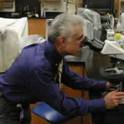
Article
Urokinase induces its own expression in Beas2B lung epithelial cells
American Journal of Physiology
(2002)
Abstract
The urokinase-type plasminogen activator (uPA) interacts with its receptor (uPAR) to promote local proteolysis as well as cellular proliferation and migration. These functions contribute to the pathogenesis of lung inflammation and remodeling as well as the growth and invasiveness of lung neoplasms. In this study, we sought to determine if uPA alters its own expression in lung epithelial cells. Using immunoprecipitation and Western and Northern blotting techniques, we found that uPA treatment enhanced uPA expression in Beas2B lung epithelial cells in a time- and concentration-dependent manner. The induction of uPA expression is mediated through its cell surface receptor uPAR and does not require uPA enzymatic activity. The amino-terminal fragment of uPA, lacking the catalytic domain, is sufficient to induce uPA expression. The serine protease plasmin and the protease inhibitor aprotinin failed to alter uPA-mediated uPA expression, whereas α-thrombin potentiated the response. Pretreatment of Beas2B cells with a tyrosine kinase inhibitor, herbimycin, suggests that activation of tyrosine kinase(s) is involved in the uPA-mediated uPA expression. Induction of uPA expression by exposure of lung-derived epithelial cells to uPA is a newly defined pathway by which this protease could influence expression of local fibrinolytic activity and other uPA-dependent cellular responses germane to lung inflammation or neoplasia.
Keywords
- urokinase,
- urokinase receptor,
- plasminogen activator inhibitor,
- alpha-thrombin,
- phosphorylation
Disciplines
Publication Date
August, 2002
DOI
10.1152/ajplung.00395.2001
Citation Information
Shetty, Sreerama, Usha R. Pendurthi, Prathap K. Shetty Halady, Ali O. Azghani, and Steven Idell. 2002. Urokinase induces its own expression in Beas2B lung epithelial cells. Am. J. Physiology, Lung Cellular and Molecular Physiology; 283: L319-L328.
